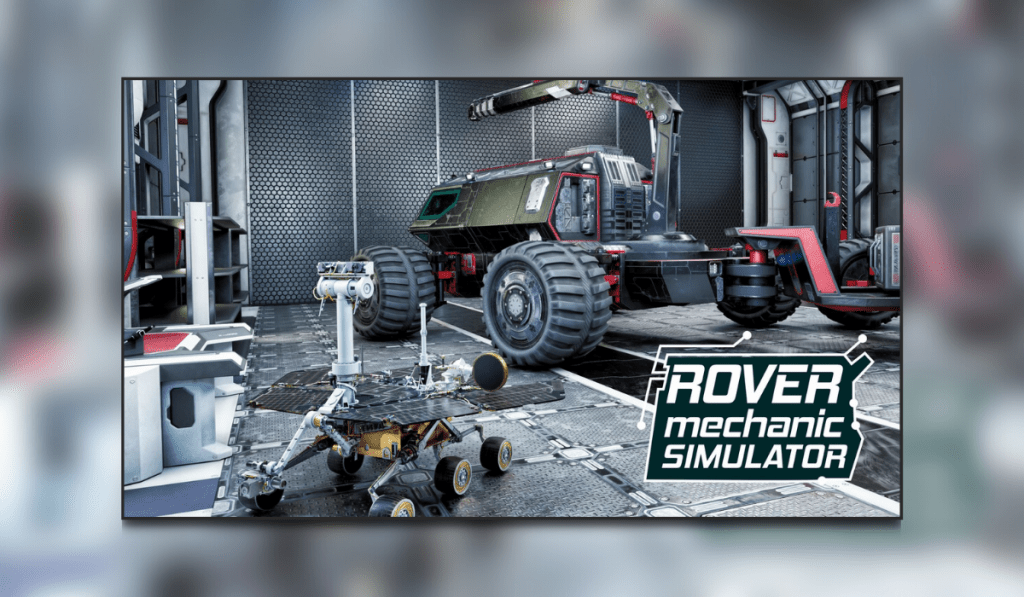
As a kid growing up I was always fascinated by space and the exploration of far off worlds. So with the release of Rover Mechanic Simulator on PS4 and having never tried a simulator before, it was time to channel my inner Mark Watney and take my first small step into the larger world of simulation games.
Houston, we have a problem
Rover Mechanic Simulator is the latest in a slew of SIM games from Polish developer Pyramid Games. It’s a single-player title where you assume the role of an engineer on one of the first Mars colonies. Your main responsibility is the analysis, repair and maintenance of the real life NASA Mars rover vehicles – Curiosity, Opportunity, Sojourner, Spirit and Ingenuity. Published by Ultimate Games this PS4 release comes in at 2.22GB and works in backwards compatibility on PS5. If you enjoy this review be sure to check out our other sim game reviews
Gameplay
Upon starting the game you are stepped through a series of tutorial guides. These teach you the ropes of navigation and how to operate the various tools at your disposal. These comprise a Crusher to recover resources by recycling bad parts and a 3D printer to fabricate replacement components. A workbench with air compressor to clean/repair parts. And last but not least, a PCB table complete with soldering iron to analyse/repair integrated circuits and the Main Control Unit (MCU) that controls the gantry crane.
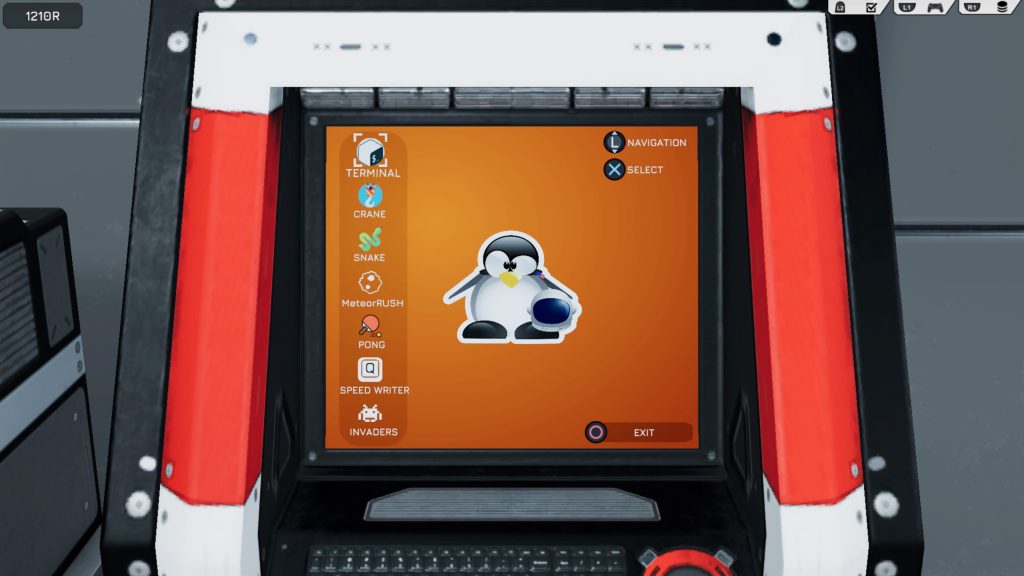
This terminal runs on a martian distro of Linux and also allows you to play a small selection of retro video games in your downtime. By playing these retro games like Snake, Pong, Asteroids and Space Invaders you can earn additional resources, the quantity of which being determined by your final score in the game – a nice and appreciated touch it has to be said. These resources can be then used to fabricate new parts for completing repairs.
Once you’ve completed the tutorial orders you are presented with an extensive list of available orders for different client companies. Each order lists the rover model along with the client note about the fault it has, the rank requirement to complete the order and the resource/XP reward you will receive upon completion. It’s then up to you to analyse the different parts of the rover to establish the faulty parts, strip parts down to their individual components where necessary in order to clean, repair or replace the faulty parts you find.
When you have finally fixed all faults you then connect a special remote connector to the vehicle to establish connection to the Rover Configurator. It’s here that you configure the vehicle via a tile puzzle reminiscent of the Dr Octavius lab puzzles you complete as Peter Parker in Insomniac’s Spiderman. These puzzles are here to test your logic and mathematical skills, an essential foundation for any wannabe engineer.

Solving these puzzles is the final task before completing your order using your tablet (by clicking the touch-pad). Signing the order as complete gives you your XP and resource rewards.
My initial few hours with the game I was thinking is this it? The controls felt clunky and unintuitive, the camera control for looking around the rover was awkward and frustrating. The whole SIM experience felt so alien to me that I wondered why this is not clicking with me…. What was I doing wrong? In my frustration, I knocked off the instrumental radio as its repetitiveness had quickly become annoying.
Feeling the loneliness and isolation of being solo in a small workshop on Mars, I pondered… What would Mark Watney do?
That’s when it hit me… I was taking the wrong approach. I had been trying to play this like a traditional game – that just wasn’t going to click. This is a simulator so I need to play like it’s real life. So I put myself in the shoes of an isolated mechanic on Mars and thought how would I keep myself entertained in this hollow white clinical room. I exited the game and opened the Spotify app on my PlayStation and fired up a playlist called “Hits From The Movies”. The result was transformative, to say the least.
Suddenly the once dreary workshop felt alive and I was bopping away to the tunes while carrying out my tasks. No longer was the frustrating camera operation or the clunky control scheme in glaring focus. The janky gantry crane was forgotten as it blurred into the four walls and the focus was on having fun dismantling, analysing and repairing the damaged vehicles.
I implore anyone to fire up such bangers as Tiny Dancer by Elton John or Fame by Irene Cara and tell me you’re not having an absolute blast tinkering away NASA style on an intricately detailed Mars rover.
On the UI front, things could do with some little tweaks. When cleaning parts and you complete the task it would be better if you were returned to the cleaning menu rather than the workbench menu. For efficiency’s sake, you’re likely to be cleaning multiple parts simultaneously (the same goes for repairing menu etc). I’d also like it if the digital display on the 3D printer displayed the remaining time for printing rather than just the percentage elapsed. This way you could simply walk over to have a quick glance to check how long left to wait for fabrication rather than having to also enter the menu.
These are minor gripes I know but all these quality of life improvements stack up and removing some of the annoying quirks from these tasks would make for an overall more enjoyable experience.
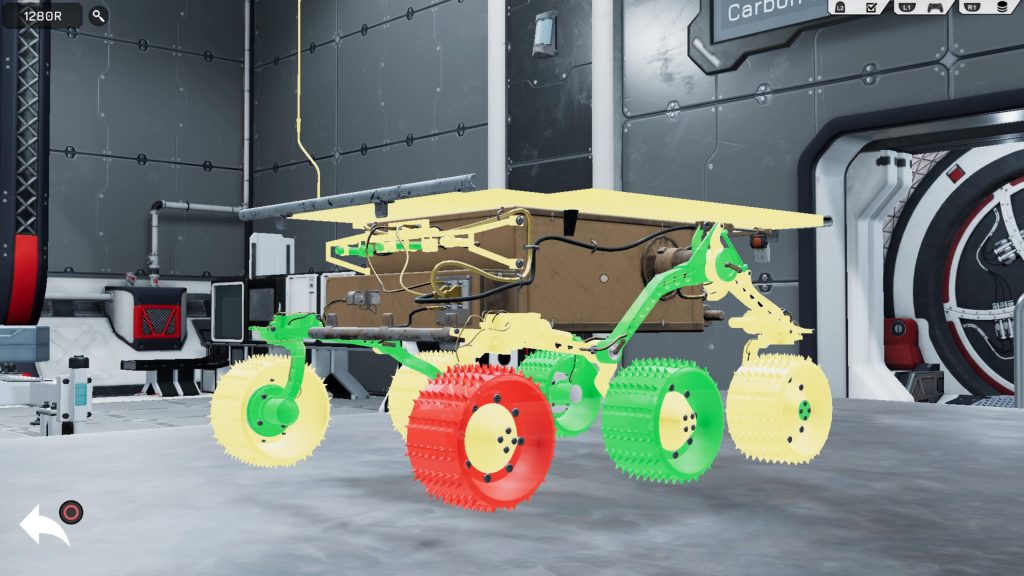
Let us take a look at accessibility. The search function of the 3D printer requires you to be able to spell correctly to quickly find and fabricate the replacement parts. Having part numbers listed in the rover analysis mode make it more approachable. As budding mechanics could use the number to find parts instead. Also, the analysis mode uses red for damaged parts and green for good parts. It would be nice to see an accessibility alternative here as this use of red and green would make the game very challenging to those who are red-green colour blind.
Graphics & Audio
The environment visuals here ain’t anything to write home about but let’s face it, it’s the rovers are the star of the show here and rightly so. The intricate detailing here shows that the team at Pyramid Games have a passion for this technology as great care and attention has been put into the meticulously recreated rover models, right down to individual components, bolts and screws.
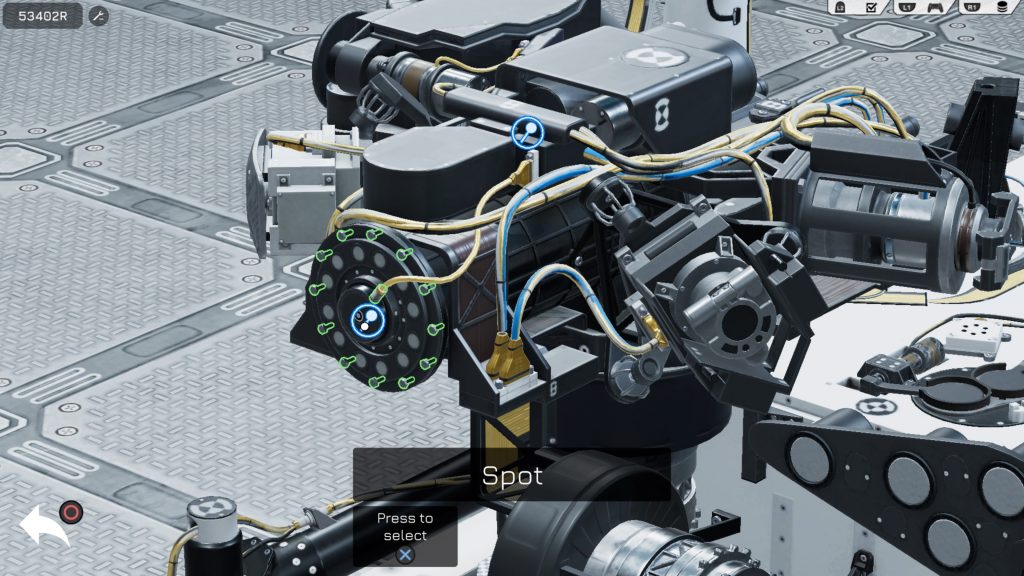
However, after your hard work, you never get to see your repair work in motion. It’d be a welcome addition to have the rovers perform some animations to show your fix put into action. I did hit a couple of graphical glitches with animations for returning screws in reassembly. When fastened back into place said screw would disappear leaving the empty screw hole visible. I also had some frame rate stutter when lowering the lift after working underneath the larger rovers.
Speaking of glitches I also had a couple of times with the rover re-configuration puzzle. After completing a lengthy repair, it was the exact same as the puzzle on the previous order I had completed. So the challenge here was null and void.
Sound-wise it all felt a bit flat. Sure the different parts have different sounds when being screwed in or out. However, some variance now and again within these sound effects would be nice and really add to the feeling of realism.
Longevity
Some orders allow you to select the type of service you would like to offer for the selected job – Standard or Premium. Standard is more of the same as what was completed on the tutorials whereas Premium is run against the clock… described by the Dev as “expert difficulty mode”. It’s a risk-reward situation as failure to complete in the specified time will knock 70% off your completion reward, but success offers additional resources and XP.
The progression system sees the skill tree partitioned into 3 upgrade sections – Technician, Economist and Analyst. Each section contains 4 tiers totalling 20 skills, with some skills having up to 3 grades within that skill. XP rewards also see you advance from lowly Starman all the way up to the lofty heights of General – Sir Yes Sir!!
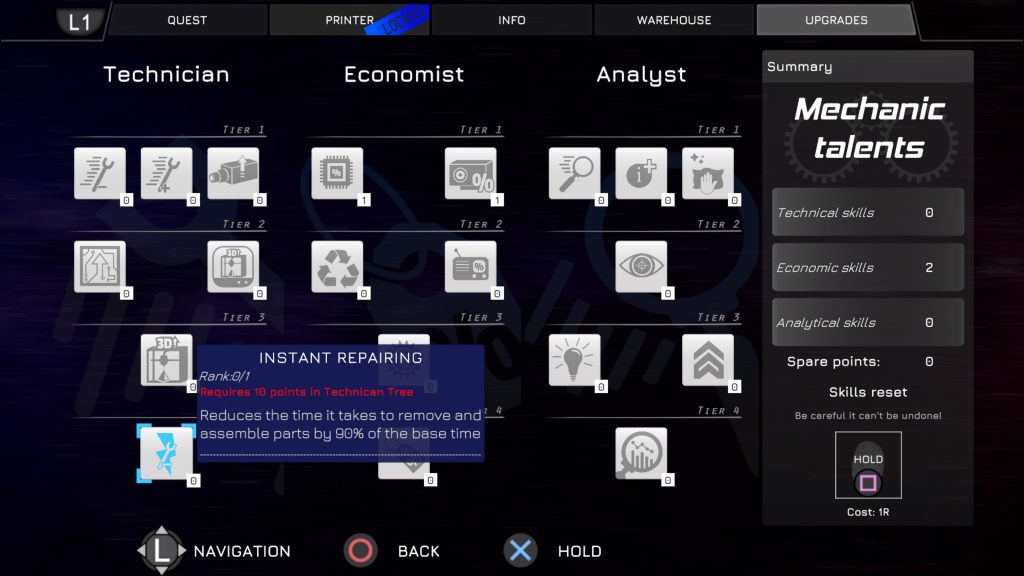
When you gain access to the Tier 2 Technician skills you can unlock the ability to upgrade the 3D printer. Once upgraded you can fabricate parts right from where you stand rather than having to walk to the 3D printer. However, you still have to walk to the printer to collect parts.
Orders become increasingly more difficult and time-consuming as you rank up, offering a steadily increasing challenge. The small number of rover models gives players time to become an expert with each vehicle. Then, before long you’re tackling Premium service orders with real purpose.
The game packs 25 trophies consisting of 8 Bronze, 10 Silver, 6 Gold and a Platinum. The only trophy that may cause issues is “Radioactive” as you have to complete a specific mission to achieve this. The platinum should take around 10-15hrs depending on skill with the aforementioned Premium service orders.
Final Thoughts
While I enjoyed learning about the rovers, how they work and what the different parts do and I can appreciate what the team at Pyramid are trying to achieve with Rover Mechanic Simulator, it’s not a game for me. The progression system didn’t offer any real benefits. I completed the premium orders with relative ease and plenty of time to spare. Some tighter balancing here might have compelled me to come back for more.
I applaud the team for the level of detail in the rovers, right down to the very small component level. It would be great to see them tackle a tightly controlling VR implementation with the same level of detail and care put into the vehicles. I think this would elevate the experience to the next level.
With some refinement to the controls, camera navigation and user interface. This could be a fantastic user-friendly learning tool for any budding NASA engineers out there. If you’re looking for a nice relaxing way to listen to some tunes/podcasts while learning about science and engineering. Then this might just be your cup of tea. Rover Mechanic Simulator nets the Thumb Culture Bronze Award.

Disclaimer: A code was received in order to write this review.

YouTube | Facebook | Twitter | Instagram | Discord | Podcast
